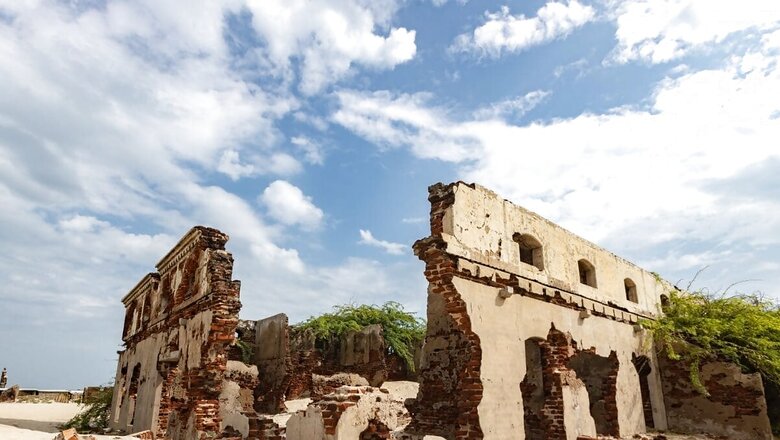
views
It’s hard to imagine how an entire city could vanish. Whether lost to war, natural calamity, or just years of gradual erosion, some of the world’s once-great cities have disappeared. Cambodia’s Angkor Wat, Greece’s Pavlopetri, and Italy’s Pompeii, to name a handful.
We look back at ten of the worst losses of the past century.
Dhanushkodi, India
Situated at the southernmost tip of Rameswaram Island, Dhanushkodi is a tourist destination known for its distinct geographical and historical significance. Commonly referred to as India’s Land’s End, the town was completely washed away by a devastating cyclone in 1964, claiming the lives of hundreds of people. Following this catastrophe, it was declared uninhabitable. Now, Dhanushkodi stands as a ghost town, with its abandoned buildings, stretches of sandy beaches, and the Kothandaramasamy Temple that remained intact during the cyclone.
Pompeii, Italy
This is one of the most famous ancient cities, probably because of the catastrophic event that led to its demise. On August 24, 79AD, while the city residents were busy with their daily lives, Mount Vesuvius erupted violently, spewing magma into the air for two days. The city and its residents, who were unable to flee in time, were buried in ash and pumice stones believed to be at least 6 meters deep.
Pavlopetri, Greece
Considered the world’s oldest submerged town, Pavlopetri is believed to have existed around 5,000 years ago before being destroyed by a series of earthquakes. It is located off the southern Laconia coast of Greece. Today, the ruins of Pavlopetri, including streets, buildings, courtyards, and even tombs, are submerged under layers of sediment.
Lion City, China
During the Eastern Han Dynasty, Lion City, also known as Shicheng, was established in the Zhejiang province of China. In 1959, the city was purposefully drowned to create the Qiandao Lake. Today, this underwater city is a renowned diving site, and the temples, roads, and houses are all nicely preserved.
Machu Picchu, Peru
Located at 2,430 meters atop a mountain crest above the Urubamba Valley in Peru, this is an ancient city of the Incas built in the 1450s for Pachacuti, an Inca Emperor. It existed for around 80 years, however, the city was abandoned in the 16th century after the arrival of the Spanish conquistadors. The ruins were discovered in 1911 by Hiram Bingham, an American historian while looking for the legendary Vilcabamba.
Baia, Italy
Roman emperors such as Nero and Julius Caesar used to vacation in this ancient Roman city. But now, much of Baia is underwater owing to volcanic activity and the gradual sinking of the land. If you are planning to visit this place, do visit the Baia Underwater Archaeological Park if you enjoy diving. You can explore the ruins of villas, baths, and temples here.
Angkor Wat, Cambodia
Angkor was the capital city of the powerful Khmer Empire, which once reigned over much of Southeast Asia. With the fall of the empire hundreds of years ago, the city was abandoned, forgotten, and fell into ruins. Now, the ruins of this ancient city can be found amid forests and farmlands to the north of Cambodia’s Tonle Sap Lake. It is a popular tourist destination as it hosts some of the world’s most stunning religious structures, including Angkor Wat, the biggest temple complex in the world.
Kolmanskop, Namibia
Believe us when we say that Kolmanskop is one of the most hauntingly yet photogenic places in the world. It was once a prosperous diamond mining town in the Namib Desert of southern Namibia. Over time, as the diamond reserves decreased, people began to flee, until nothing was left but vacant homes and establishments. Today, the entire town is covered in desert sands.
Aral Sea, Kazakhstan/Uzbekistan
The Aral Sea was known as the world’s fourth-largest lake, but it has shrunk dramatically since the 1960s due to the Soviet Union’s diversion of rivers for irrigation projects. This ecological calamity has resulted in the nearly complete disappearance of the sea, leaving behind dry, desolate terrain and abandoned fishing ports like Aralsk.
Port Royal, Jamaica
Port Royal was once a booming hub of piracy and trade in the Caribbean, earning the moniker ‘wickedest city on Earth.’ In 1692, a massive earthquake struck the island, sinking two-thirds of the city into the sea. It was followed by a tsunami, and now the remains of Port Royal can be explored through diving expeditions.




















Comments
0 comment